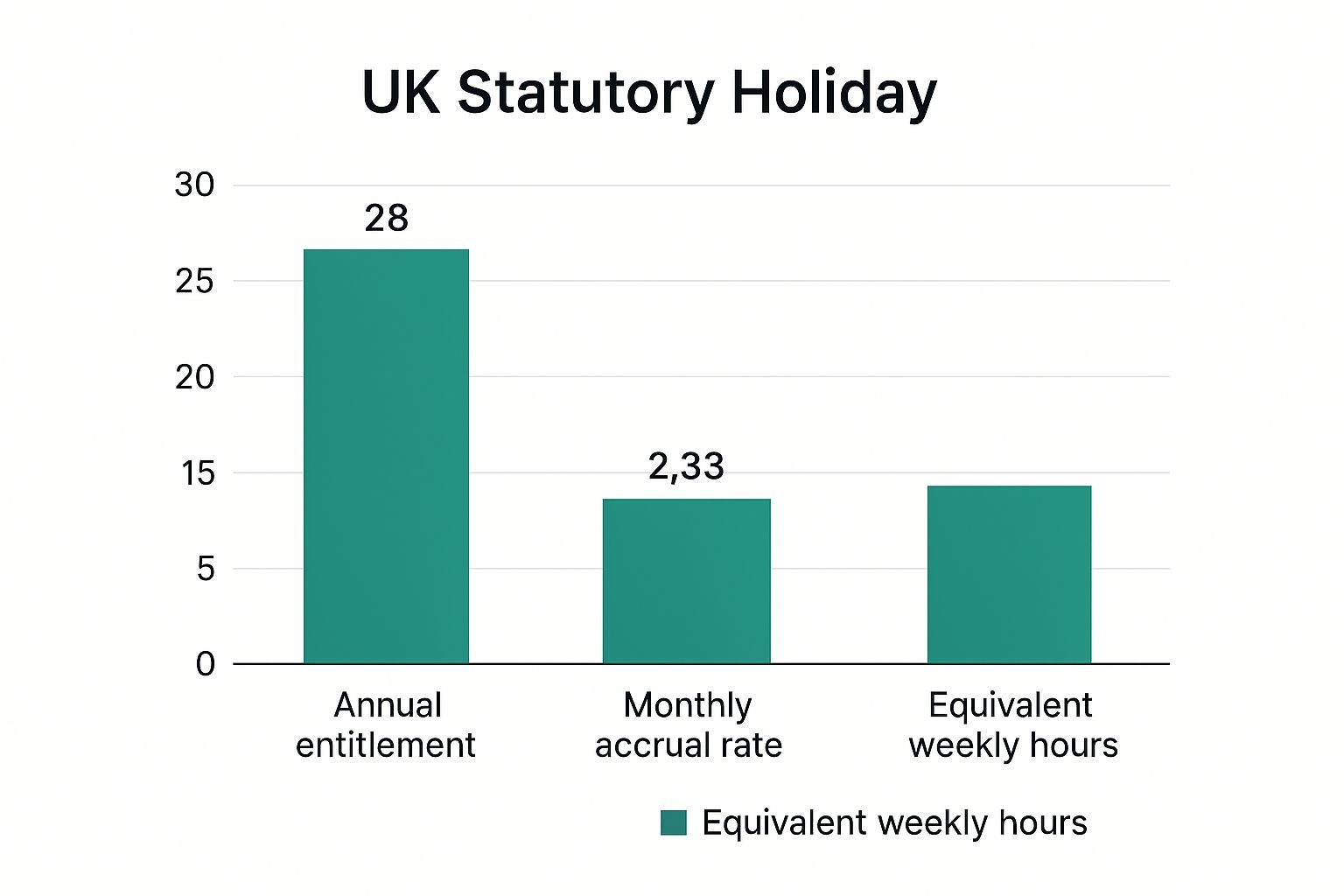
Holiday Calculator UK | Your Guide to Annual Leave
Posted by Robin on 29 Sep, 2025 in
Trying to figure out your annual leave entitlement in the UK can feel like a bit of a headache, especially when you factor in different working patterns. But the good news is, the whole system is built on a surprisingly simple foundation.
At its heart, UK law guarantees almost every worker a minimum of 5.6 weeks of paid holiday each year. This is your baseline, your non-negotiable minimum.
Think of it as your guaranteed time to recharge. For someone working a typical five-day week, the maths is straightforward: 5.6 weeks multiplied by 5 days equals 28 days of paid leave.

What About Bank Holidays?
This is where things can get a little fuzzy for people. Do bank holidays count towards your 28 days or are they on top? The answer is: it depends on your employer. Your contract is your source of truth here.
There are two common ways businesses handle this:
- Inclusive: Your 28 days of statutory leave include the bank holidays. So, if there are 8 bank holidays in a year, you have 20 days left to book whenever you like.
- Exclusive: Your employer gives you 28 days of leave plus the bank holidays as extra paid days off. This is a more generous approach, but it's a contractual perk, not a legal requirement.
It's worth remembering that an employer can always offer you more holiday than the legal minimum (this is called 'contractual entitlement'), but they can never, ever offer less. The statutory 5.6 weeks is the absolute floor.
Knowing which camp your company falls into is crucial for keeping track of your time off. For a more detailed breakdown of all the rules, our ultimate guide to UK statutory holiday allowance is a great resource.
This is also why a reliable holiday calculator uk becomes so handy. It takes the guesswork out of the equation, automatically applying these rules to calculate leave for different work patterns, ensuring everything is fair, square, and legally compliant.
The Story Behind UK Bank Holidays
Ever found yourself wondering why we get a handful of Mondays off during the year? These aren't just happy accidents in the calendar. They’ve got a fascinating history that still shapes how your annual leave is calculated today, and understanding where they came from is the key to seeing why a holiday calculator UK tool is so handy.
Let’s rewind to the Victorian era. Before any official laws, holidays were a bit of a free-for-all, usually tied to tradition or religion. This created a messy patchwork of days off across the country, with little consistency. That all changed with the Bank Holidays Act of 1871.
This landmark act, pushed forward by Liberal politician Sir John Lubbock, was the first to formalise the idea of a "bank holiday." It started small, marking just four days off in England and Wales: Easter Monday, Whit Monday, the first Monday in August, and Boxing Day. It's interesting to explore the history of UK bank holidays to see how we got from four days to the calendar we know now.
From Legal Act to Workplace Norm
The 1871 act was a game-changer. It gave a legal footing to days off that were previously just customary. The name is pretty literal, too – if the banks were shut, most other businesses couldn't really function, creating a domino effect that gave almost everyone a day of rest.
Over the years, the list grew. New Year's Day and May Day joined the party, and Whit Monday was eventually shifted to become the Spring bank holiday we have today.
But here’s the crucial bit that trips people up: The original principle from 1871 still stands. Bank holidays are created by law, but they don't automatically grant you a paid day off. It’s your employment contract that dictates whether you get that day off with pay.
This little piece of history is the root cause of so much confusion around holiday entitlement. Some companies roll the 28-day statutory minimum and bank holidays into one pot. Others offer the bank holidays on top as an extra perk.
This is exactly why getting it right matters. Your employer’s policy directly impacts how many "floating" holiday days you have left to book yourself. It’s a critical detail that any accurate holiday calculation has to factor in, showing just how important a clear system or tool is for managing your leave properly.
Calculating Holiday for Full-Time Employees

Thankfully, for most full-time workers in the UK, figuring out your holiday entitlement is refreshingly simple. The whole calculation hinges on the statutory minimum of 5.6 weeks of paid annual leave.
Think of it like this: the law gives you the number of weeks, and you just need to multiply that by the number of days you work each week. If you're a typical Monday-to-Friday employee, the maths couldn't be more straightforward.
5.6 weeks x 5 days per week = 28 days of paid holiday.
This 28-day figure is the baseline, the absolute minimum your employer must provide for a standard full-time role. It's the legal floor. If you're looking for a wider view on tracking time off, these steps for accurate time off tracking can offer some great insights.
How Bank Holidays Fit into the Calculation
This is where you need to get your contract out and read the small print. While the total entitlement is 28 days, the way companies handle bank holidays can differ quite a bit. There are generally two ways they play it.
- The Inclusive Method: Your 28 days already include all bank holidays. So, if there are 8 bank holidays in a year, you’re left with 20 days to book off whenever you like.
- The Exclusive Method: You get 28 days of annual leave plus the bank holidays as extra paid days off. This is a much more generous offer, known as contractual entitlement, because it goes above and beyond the legal minimum.
An employer must always meet the statutory minimum of 28 days but can choose how to incorporate bank holidays within that total. Your contract is the final word on which method your company uses.
Statutory vs Contractual Entitlement
Getting your head around this distinction is the key to truly understanding your annual leave. The law sets the floor, not the ceiling.
- Statutory Entitlement: This is the legal minimum of 5.6 weeks (28 days for someone working a 5-day week). No employer can legally offer you less.
- Contractual Entitlement: This is anything your employer offers on top of the statutory minimum. It’s a perk, an extra benefit outlined in your employment contract.
Calculating your entitlement is the first step, but it’s also crucial to understand the total number of https://blog.leavetrackapp.com/articles/how-many-working-days-in-a-year-uk-edition to plan your time off effectively. Whether you’re doing the sums yourself or using a holiday calculator, getting these basics right ensures you always get the time off you're entitled to.
Mastering Pro-Rata Holiday Calculations
Part-time work offers fantastic flexibility, but let’s be honest, it often creates a headache when it comes to figuring out holiday entitlement. The good news? The principle behind it is refreshingly simple: your holiday is directly proportional to how much you work. This is what’s known as pro-rata entitlement.
Instead of the standard 28 days for a full-timer, your leave is scaled down to fairly match your working pattern. This whole system is designed to make sure part-time staff get the same fair treatment as their full-time colleagues, just adjusted for their hours.
Think of it like a pizza. A full-time employee gets the whole pizza (representing 28 days). If you work three days a week instead of five, you get three-fifths of that pizza. It’s a straightforward calculation that ensures everyone gets their fair slice.
The Core Pro-Rata Formula
Calculating holiday for part-time staff is beautifully simple once you know the formula. You just take the standard full-time entitlement of 5.6 weeks and multiply it by the number of days you work each week.
Let's walk through a quick, clear example:
- An employee works a regular pattern of 3 days per week.
- The calculation is: 5.6 weeks x 3 days
- This gives them a total entitlement of 16.8 days of paid holiday per year.
This simple bit of maths is the foundation for almost every part-time holiday calculation. Whether you’re using a spreadsheet or a dedicated holiday calculator UK tool, this is the logic ticking away behind the scenes.
The table below shows how this plays out for different working patterns.
Example Pro-Rata Calculations for Part-Time Work
| Days Worked Per Week | Calculation (5.6 weeks x days) | Total Annual Holiday Days |
|---|---|---|
| 1 Day | 5.6 x 1 | 5.6 |
| 2 Days | 5.6 x 2 | 11.2 |
| 3 Days | 5.6 x 3 | 16.8 |
| 4 Days | 5.6 x 4 | 22.4 |
As you can see, the entitlement scales perfectly with the number of days worked each week.
Dealing with Holiday Day Fractions
Wait, 16.8 days? How can anyone take 0.8 of a day off? This is a really common question, but thankfully, the solution is straightforward. Employers generally have two options for handling these fractions:
- Rounding Up: This is the most common and employee-friendly approach. The entitlement is simply rounded up to the nearest half or full day. So, in our example, 16.8 days would become 17 days.
- Paying for the Fraction: An employer might choose to pay you for that 0.8 of a day, usually at the end of the holiday year. Another option is to let you take that time off in hours (for instance, if a standard day is 8 hours, 0.8 of a day works out to be 6.4 hours).
Critically, an employer is not legally allowed to round your statutory holiday entitlement down. They must either round it up or pay you for the fraction of a day you're owed.
This infographic breaks down the core components of UK statutory holiday, from the annual total to the monthly accrual rate.

It’s a great visual comparison that shows how the 28-day annual entitlement builds up over the year, accruing at a steady rate of 2.33 days each month.
Calculating Accrued Holiday Mid-Year
What happens if you join or leave a company part-way through the year? Your holiday is simply calculated on a pro-rata basis for the portion of the year you actually worked.
For someone starting mid-year, you’d first work out their total entitlement for a full year. Then, you divide that by 12 (for the months in a year) and multiply it by the number of months they are set to work.
Example: Starting on 1st July
Imagine an employee who works 3 days a week starts their new job on 1st July. This means they will work for 6 months of the company's holiday year.
- Full Year Entitlement: 5.6 weeks x 3 days = 16.8 days
- Monthly Accrual: 16.8 days ÷ 12 months = 1.4 days per month
- Total for 6 Months: 1.4 days x 6 months = 8.4 days (which would be rounded up to 8.5 or 9 days).
The exact same logic applies when an employee leaves. You calculate what they have accrued up to their final day to figure out their final holiday pay. Using a digital holiday calculator UK tool can automate all of this, preventing mistakes and keeping everything compliant.
Navigating Holiday Differences Across UK Nations

It’s a classic mistake to think a bank holiday in the UK is the same for everyone. This little assumption can cause some serious headaches for businesses. Did you know a day off in Glasgow could be just another Tuesday in Cardiff? The United Kingdom is made up of four nations, and each one has its own unique calendar of public holidays.
This isn't just a fun fact; it has real-world consequences for calculating annual leave, especially if you have remote workers dotted across the country. These variations are tied to regional history and culture, creating a patchwork of dates that a one-size-fits-all approach just can't handle.
For example, St Patrick's Day is a big deal and a public holiday in Northern Ireland, but it's business as usual everywhere else in the UK. Meanwhile, Scotland enjoys an extra day off at the start of January and celebrates St Andrew's Day in November. It all adds another layer of complexity to keeping your holiday records straight.
Why Location Matters for Holiday Calculation
Getting these regional differences right is crucial for being fair to your team and staying on the right side of the law. An employee based in Belfast has a different set of guaranteed public holidays compared to a colleague working from Bristol. If your business operates across the UK, you have to factor in these local calendars to make sure every single employee gets their correct entitlement.
The UK's bank holiday calendar is a reflection of these deep-seated regional distinctions. England and Wales typically have eight bank holidays, Scotland gets nine, and Northern Ireland has ten. You can dive deeper into these public holiday differences across the United Kingdom to see just how much the calendars vary.
This is precisely where a manual spreadsheet starts to crack under the pressure. If you don't account for an employee's specific location, you're almost guaranteed to miscalculate their holiday allowance, leading to frustrated staff and potential compliance trouble.
Keeping Track of Regional Variations
For any HR manager or team leader, trying to manually track all these different calendars is a massive time-drain and an open invitation for errors. Just imagine trying to coordinate a project deadline around a holiday that only half your team is actually taking off.
Here are a few key examples of holidays that are specific to certain regions:
- Northern Ireland: St Patrick's Day (17th March) and Battle of the Boyne/Orangemen's Day (12th July) are major public holidays.
- Scotland: An additional bank holiday on 2nd January and St Andrew's Day (30th November) are standard.
- England and Wales: Share the same calendar, including holidays like the August Bank Holiday.
This really brings home why a proper holiday calculator UK tool is so essential for any modern business. A good system automatically applies the correct public holiday calendar based on where an employee lives. It ensures everything is accurate and consistent without you having to lift a finger. It takes a logistical puzzle and turns it into a simple, automated process.
Why a Digital Holiday Calculator Is Your Best Friend
After wrestling with the maths for pro-rata and full-time leave, it’s pretty obvious that doing it all by hand is a bit of a minefield. Trying to keep track of everything on a spreadsheet is like using a paper A-Z map in the age of sat navs—it’ll get you there eventually, but it’s slow, full of potential wrong turns, and quickly becomes a huge admin headache.
This is where a digital holiday calculator changes the game entirely. It takes leave management from a tedious, error-prone chore to a smooth, automated process.
The biggest win? No more human error. A single typo in a spreadsheet formula can easily lead to incorrect holiday pay or unfair leave allowances, which is a recipe for frustration among staff and management. Automation just gets rid of that risk, making sure every calculation is spot-on and fully compliant with UK law.
Save Time and Boost Transparency
Beyond getting the numbers right, the time saved is enormous. A key advantage of a digital holiday calculator is its power in automating repetitive tasks, freeing up your HR team and line managers to focus on work that actually pushes the business forward.
It’s a massive benefit for employees, too. They get an instant, clear picture of their remaining entitlement without having to chase anyone for an answer.
This kind of transparency builds trust and empowers your team to plan their time off properly. It's especially vital during peak times, like the August Bank Holiday, when everyone wants time off and you need to coordinate carefully to avoid chaos. In fact, during one recent August Bank Holiday, an estimated 20% of adults in Britain planned a UK-based holiday, which really shows why you need clear visibility to prevent clashes. You can dive deeper into how UK residents plan their holidays by reading this VisitBritain trip tracker research.
A digital calculator isn't just for counting days. It's a central hub for planning, preventing scheduling conflicts, and ensuring fairness across the entire organisation, making it an indispensable asset.
Ultimately, these systems do all the heavy lifting for you, including automatically applying regional bank holidays. For any business with staff across the UK, you can learn more about how Leavetrack simplifies importing public holidays for different nations.
Got Questions About UK Holiday Calculations? We've Got Answers
Figuring out the nuts and bolts of annual leave can bring up some perplexing real-world scenarios. To make sure you feel totally on top of things, we’ve tackled the most common questions that pop up around UK holiday calculations with some clear, no-nonsense answers.
What Happens to Holiday Accrual During Maternity or Sick Leave?
This is a big one. People often wonder what happens to their holiday allowance when they're off work for a long stretch. The good news is, your statutory paid holiday entitlement keeps building up, even while you’re on sick leave or statutory maternity, paternity, or adoption leave.
It’s as simple as that – your allowance grows just as if you were still at your desk. It's usually best practice to take any leave you built up before your absence either before you go or when you get back. Every situation is a bit different, so have a chat with your employer. They might let you carry a certain number of days over if a long-term leave made it impossible to take them.
Can My Boss Tell Me When to Take My Holiday?
In a word, yes. Your employer can legally tell you when to take your annual leave. This often happens when a company has a planned shutdown, like over the Christmas period. But they can’t just drop it on you at the last minute.
The law says they have to give you proper notice. The rule is straightforward: the notice period must be at least twice as long as the holiday they want you to take.
- For one week of leave: They need to give you at least two weeks' notice.
- For two days of leave: They need to give you at least four days' notice.
And it works both ways. This same notice rule applies if they need to cancel a holiday you’ve already had approved.
How Does Holiday Pay Work for Zero-Hour Contracts?
For staff with irregular hours or those on zero-hour contracts, holiday entitlement is worked out based on the hours they've actually put in. The go-to method uses a specific percentage: 12.07%.
Where does that number come from? It's not just plucked out of thin air. It’s calculated from the statutory 5.6 weeks of holiday. Take the 52 weeks in a year, subtract the 5.6 weeks of leave, and you get 46.4 working weeks. The 5.6 weeks of holiday is 12.07% of those working weeks (5.6 ÷ 46.4 = 12.07%). So, for every 100 hours worked, an employee earns just over 12 hours of paid time off. A good UK holiday calculator makes this an instant, error-free sum.
What's the Difference Between Statutory and Contractual Holiday?
Finally, it’s really important to get your head around these two terms. They're not interchangeable.
- Statutory Holiday: This is the legal minimum entitlement that every single worker in the UK is guaranteed. It's set at 5.6 weeks per year. An employer can never, ever offer less than this.
- Contractual Holiday: This is any extra paid leave your employer gives you on top of the legal minimum. Think of it as a perk of the job, and you'll find the details in your employment contract.
Trying to manage all these rules by hand is a surefire recipe for headaches. With Leavetrack, you can automate all your holiday calculations, handle requests without the back-and-forth, and make sure everything is fair and compliant for your whole team. Make your life simpler by visiting https://leavetrackapp.com to see how it all works.
